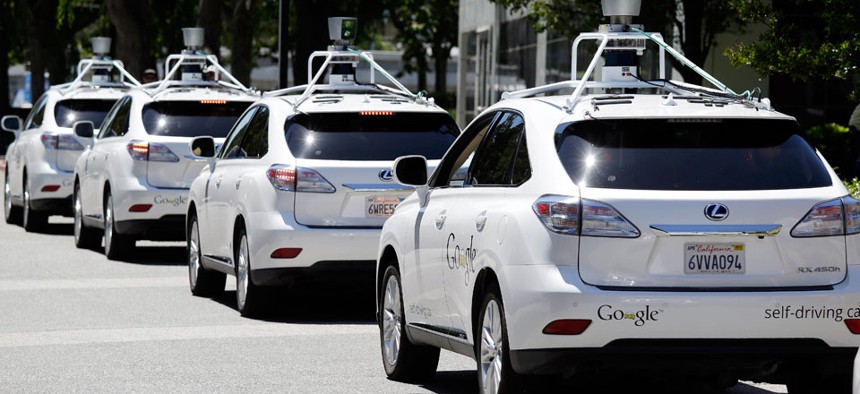Why Self-Driving Buses -- Not Cars -- Are the Future of Transportation

A row of Google self-driving cars are shown outside the Computer History Museum in Mountain View, Calif. Eric Risberg/AP File Photo
The autonomous car will not be nearly as autonomous as its champions would have you believe.
The self-driving car has traveled a long and lonely road to get here. Introduced to the American public by General Motors at the 1939 New York World’s Fair, the Depression-era dream of automated highways has perpetually lagged behind the present in drivers’ rear-view mirrors.
But thanks largely to Google, the future once again appears to be gaining on us. A panel of Silicon Valley technology leaders recently polled by The Atlantic expects the first fully autonomous models to roll into our driveways in 2022.
But don’t count on it. The autonomous car will not be nearly as autonomous as its champions would have you believe.
When Google’s car took its first official driving test in Nevada in 2012, it struggled at times to pass—and this was on a course and under conditions of the company’s choosing. According to the state examiner’s log published last month by IEEE Spectrum, the self-driving Toyota Prius needed human help making turns and surrendered control completely when faced with the ambiguous terrain of roadside construction. The car wasn’t tested at all at railroad crossings or roundabouts, and Nevada’s DMV had agreed beforehand not to drive it in snow, ice or fog—none of which the car was designed to operate in.
Of course, self-driving cars will get smarter as computing power increases. But they will quickly encounter another real-world complication: other breeds of self-driving cars. In September, California joined Nevada in granting autonomous licenses, and within hours Audi and Mercedes-Benz squeezed ahead of Google in securing permits. There were merely the first in line. General Motors’ Cadillac division announced in August it would offer limited autonomy by 2017, and Tesla Motors CEO Elon Musk recently unveiled the Model D, an electric sedan with its own semi-autonomous features.
Further complicating matters will be unpredictable human drivers, who won’t give up their cars en masse. A survey of 1,533 US, UK, and Australian drivers published by University of Michigan researchers in July found that a majority of respondents had serious concerns about riding in autonomous cars—and more to the point, they wouldn’t pay extra for them. It’s taken more than a decade for drivers to seriously consider switching to hybrid and electric vehicles; it will take decades more to achieve a majority of self-driving vehicles on the roads.
As a result, by the time Google’s cars are ready for sale, they will have to share the roads with a slew of models produced by dozens of automakers, each with its own scheme for avoiding collisions. With traditional rules of the road shoved aside by overly cautious computers, one result might be epic gridlock, as they slow to a crawl attempting to work it out. Meanwhile, all the focus on vehicular autonomy has overshadowed the slow progress on essential protocols for car-to-car communications, an essential technology for mass automation of our roads. Drivers can expect years of technical and legal wrangling in addition to incompatibilities and glitches as Google’s and Tesla’s cars try to talk while traveling 60 miles (96 km) per hour. Tough security problems abound and various proposals to shuffle the unique ID of your car—so that it doesn’t become a privacy-compromised tracking device like your phone—have yet to be worked out.
Google knows this game well. The 20-year history of the commercial internet has been marked by brawls between corporate giants over which program or protocol should be the industry standard. Microsoft won the Web’s “browser wars” of the 1990s and ultimately lost an antitrust case because of it.
Looking at the wrong problem
That said, Google’s greatest shortcoming isn’t its technology, but how it has defined America’s transportation challenge. Our public transportation systems are running near historic highs in ridership, while using technology and business models from the 19th century. We should be upgrading these, not trying to fix America’s auto-dependent suburbs.
Consider buses. These are experiencing a renaissance as cities around the world, from Bogota to Guangzhou to Jakarta, have shown how bus rapid transit can be a faster, cheaper, more flexible and energy efficient way to move large numbers of commuters than either cars or trains. Now what if those buses—like the private automobile “platoons” envisioned by the auto industry—could travel safely only feet apart at top speeds?
This scheme could solve some of the most challenging transportation problems facing American cities. With its rail tunnels in desperate need of repair after Superstorm Sandy in 2012, the New York region needs alternative ways of moving commuters across its rivers. According to a recent estimate (pdf, p. 11) by Jerome Lutin, New Jersey Transit’s former director of planning, and Alain Kornhauser, the head of Princeton University’s transportation program, if self-driving buses could maintain a safe separation of just six feet (1.8 m)—well within near-term technological capabilities—the bus lanes of the Lincoln Tunnel, connecting New York City to New Jersey, could accommodate over 200,000 passengers per hour, more than five times today’s throughput.
Google’s engineers may have resurrected the dream of fluid mobility, but they have a lackluster vision of how to implement it. Before we chase the ghosts of yesterday’s tomorrows, we need to think harder about how self-driving vehicles will actually perform in the real world, and more important, how they can be used not just to repair but to reinvent our transportation systems.





